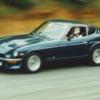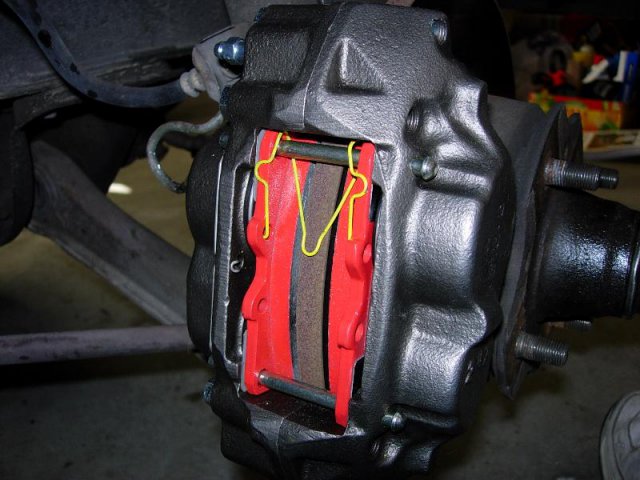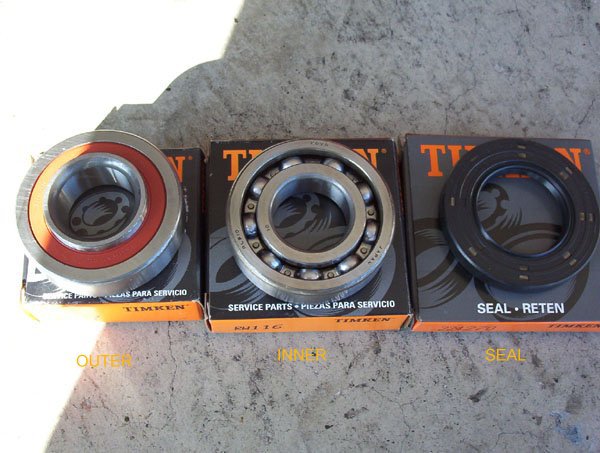-
Posts
820 -
Joined
-
Last visited
-
Days Won
3
Content Type
Profiles
Forums
Blogs
Events
Gallery
Downloads
Store
Everything posted by zcarnut
-
Sorry for the late reply, but I just noticed your recent post. On my 1979 Datsun 810 (two-door hardtop) I used the ECU, the mass air flow sensor (the “hot-wire” type), the injectors, the O2 sensor and the fuel injection wiring harness (that was cut up to fit) from a 1987 NA (non-turbo) Z31. I also swapped out the 48mm diameter 810 throttle body with the 60mm 240SX one, swapped the intake manifold with the non-egr N42 one and used one of the aftermarket Z car fuel rails. I left the cable linkage on the 240SX throttle body and ran a throttle cable to my accelerator pedal. This also made adapting the cruise control easier. For the trigger signal I used a 280ZX turbo distributor re-fitted with the Z31 optical trigger wheel. The ZX turbo distributor requires using its own unique oil pump driveshaft. I retained the stock 810 electric fuel pump, but because the Z31 fuel pump is driven from both of its wiring leads, I designed an “interface circuit” to power the 810 fuel pump without having to re-wire it. The Z31 injectors I got were the “high impedance” type, so I got rid of the stock injector dropping resistors. The Z31 uses an O2 sensor to help adjust the mixture which I had to add to the exhaust head pipe of the 810. I used the 810’s cruise control sensor as the “speed sensor” for the Z31 ECU. If you don’t then the hot-wire “burn-off” (cleaning) function will not work. I mounted the Z31 ECU where the 810 was (driver’s side kick panel). For the ignition circuit I used a 280ZX coil and ignitor box but you can also use the Z31 ignition items. I first tried to mount the Z31 mass-air flow sensor between the throttle body and the 810 air-box, but I discovered that the later Maxima mass-air flow sensor could be made to bolt to the side of the 810 air box. At first I was going to transfer the “guts” of the Z31 air mass sensor to the Maxima one, but I decided to try the Maxima one “as is” and it seemed to work just fine. I eventually swapped out my 810 air box to the 1981-84 Maxima diesel air box which has more volume. The only reason I went this route was the fact that I had obtained a Z31 parts cars for very little cost. The L28 in the 810 has been stroked and bored out to 3 liters, so the Z31 fuel map is close enough. During the swap I made notes and diagrams that I kept in a notebook, but I have not been able to locate it after I moved to Huntsville last year. I’ll keep looking for it.
-
As long as the pulley is rotating, the bearings are turning as well regardless of whether the clutch is engaged or not, so they cannot be seized. That is, the bearings just support the AC compressor pulley. The clutch disc on the front of the compressor is connected internally to the swashplate which houses the rotary pistons. When the clutch is engaged, the clutch disc is flexed by a magnetic field and makes contact with the pulley. Rust can build up on the contact surfaces of the pulley and clutch disc, especially when the compressor is inactive, but the rust layer is removed after a few cycles of on-off operation. There is spec for the air gap between the two contact surfaces (.020†to .015†or so) when the clutch is disengaged. Be careful with the lubricate as friction is necessary for the clutch to operate. You can remove the clutch disc for a closer inspection by first removing the lock washer and then the 8mm nut at the front of the compressor. Use a snap-ring pliers or a needle-nose pliers to remove the threaded collar and gently pry the disc off. Be sure to watch out for the air gap adjusting shims and the shaft key! You do not want to loose them. Also, make sure that the head pressure at the output of the compressor is not too high. Measure this with a refrigerant gauge screwed into the high side Schrader valve. It should be less than 200psi. Too high a level will cause the ac compressor to actually rotate backwards when it has been disengaged. Too much pressure is caused by a restriction in the condenser or receiver/dryer or having too much R12 in the system.
-

New Rear Brake Swap??????
zcarnut replied to zpizzaman20's topic in Brakes, Wheels, Suspension and Chassis
The rotor looks like the 1985-88 front Maxima. Funny, he does not mention that you will not have a parking brake after making this “mod”. -
You want to use an NPN Darlington bipolar transistor. Something with ratings of 10A and 450V. A Motorola MJ10012 or similar should work. 2N6505? NO! That’s an SCR (silicon controller rectifier) and will not work.
-
The paper-thin gasket between the tensioner and the block was installed by Nissan at the factory. However, it was never identified separately in the Nissan Parts manual (fiche) so you were never able to get it from Nissan and hence none of the aftermarket gasket suppliers ever included it. It may have been included if you purchased a NOS tensioner, but everyone now uses aftermarket timing chain kit parts due to cost and availability. The standard accepted practice is that the tensioner gasket is not used/needed. Usually the tensioner body and the engine block are already smooth enough. If you are anal about it then you can surface the new tensioner with some valve ginding compound over a piece of glass. Any minor oil leaks between the tensioner and block are inconsequential as the tensioner is a “calibrated oil leak” to lubricate the timing chain. I have rebuild over a dozen L-series engines and I have never used a gasket under the tensioner and never had a problem.
-

Toyota S13W calipers dimensions
zcarnut replied to Noddle's topic in Brakes, Wheels, Suspension and Chassis
Because the S13WB caliper is designed to be used with a 26 to 28mm thick rotor whereas the S12W calipers are designed to be used with a 22mm thick rotor. Check out the photos in the first post of this thread. If you are using the S13WB caliper with a 22mm thick rotor (like the Z31 rotor) then there is a chance that the caliper pistons may actually come out of their bores when the pads and the rotors have been worn down to their limits. Since the S13W caliper is slightly wider and a weighs a little more than the S12W caliper, there is no advantage in using the S13W caliper over a S12W unless you want to use a thicker rotor. I have used a 26mm thick Saab rotor with the S13W caliper on the S30 Z cars, but this requires machining the rotor to reduce its OD. -

1981 280zx non turbo flywheel bolt up in a 1988 300zx nonturbo
zcarnut replied to bumble zee's topic in Drivetrain
No. The L-series flywheel will not bolt on to an VG-series crankshaft. The bolt mounting flanges of the flywheels are not the same and the method of centering the flywheel with respect to the crankshaft is different. I did not measure to determine if the bolt pattern was the same. If it is the same, then you might be able to machine the flywheel so it would fit. -

Halogen replacement bulb for reverse light
zcarnut replied to Derek's topic in Ignition and Electrical
Yes, I have. Nice improvement, but if you leave the reverse lights on for over five minutes you will melt the plastic socket that holds the bayonet base! -
Where are you at? I grew up in Johnson City. Back in the 1970's there were lots of Z cars all over that area. There was even a "Z junkyard" (way before the Z Barn) in Greeneville.
-

Engine won't rev past 2,000 RPM - just cleaned engine bay
zcarnut replied to PhilbertZ's topic in S130 Series - 280ZX
http://www.eagleday.com/ampconnectors.html AMP-CON-BOOT $3.95 I have also seen a similar item on eBay in the past. -
Great detective work NZeder and rudypoochris! I think I’ll order a couple for spares. Considering that the most of the R200’s have 100K+ miles on them before re-build, I’ll be content with using the stock (non-ceramic) bearing.
-

Engine won't rev past 2,000 RPM - just cleaned engine bay
zcarnut replied to PhilbertZ's topic in S130 Series - 280ZX
The water completes a high impedance circuit and tells the ECU that the engine is under de-acceleration. In this mode the ECU shuts off the injectors at any rpms over 2800. No. It will not dry out on its own. The entry point is so small that you will not get the exchange of air necessary for evaporation to occur. Also, water can enter the TPS connector through cracks where it has the same results. -

Engine won't rev past 2,000 RPM - just cleaned engine bay
zcarnut replied to PhilbertZ's topic in S130 Series - 280ZX
Water in the TPS (throttle position switch). Remove with a blast of compressed air. Very common problem.... -
No. The 1970-77 alternators used an external voltage regulator. The '78 and up alternators had the regulator built into the alternator, i.e., they were internally regulated.
-
Looks like a viscous LSD to me. The viscous unit is shown as item number 38411 on the fiche page of the VLSD version of the Z31. The viscous unit is sealed and the pics supplied by Jon appear to be “non†VLSD diffs.
-
Yes. I was in error. However, the S13WB pistons are actually 45.3mm in diamter.
-
Having studied the spacer concept for the R200 front bearing previously, I think the spacer should be a “tight†interference fit (or shrink fit) onto the bearing but it should be a “light†interference fit when the bearing/spacer combination is pressed into the R200 housing (pinion opening). This will ensure that the spacer will not move after installation and yet will allow easy removal. Your figure of 57.5mm for the inside diameter (ID) of the spacer is way too small. Typically, a “tight†interference fit requires a mismatch of .002 to .003 inches. Using 57.5mm your interference is 0.5mm or .0197inches. You would likely break the parts trying to press them together with this much mismatch. I would start with a spacer having an ID of 57.925mm which is 58mm less .003â€. The outside diameter (OD) of the spacer with the bearing installed should be .0005 to .0002 larger than the ID of the R200 housing (73mm) for a “light†interference fit. This would imply that the OD of the spacer should be around 73.01mm after machining, however, the process of pressing the bearing into the spacer (because it is an interference fit) will actually increase the OD of the spacer. Exactly how much depends on several factors, but it will be almost the amount of the interference (.003). So, start with a spacer OD of 73mm less .003†*.8 plus .0004†or 79.95mm.
-
This guy has a lead on NOS RHD dashes: http://www.new-datsun-parts.com/datsun-240Z-parts-interior1.html Get you wallet out--$2145.00 each (!)
-

Pad Springs on the S12+8 calipers
zcarnut replied to Astral Ace's topic in Brakes, Wheels, Suspension and Chassis
No. It’s always a good idea to have the “shims†between the pads and the pistons. (They are not called “backing platesâ€.) The shims are there to reduce or prevent brake squeal. Also, since they are stainless steel, they reduce the amount of heat reaching the pistons which then can be passed on to the brake fluid. -

Pad Springs on the S12+8 calipers
zcarnut replied to Astral Ace's topic in Brakes, Wheels, Suspension and Chassis
-
The R180 and the R220 input (front) flanges do not interchange because the pinion shaft diameters are different.
-
What happens when you add the inner wheel bearing to your pre-assembly? The inner bearing goes between the spacer and the companion flange, so it should allow the companion flange to rest just on the splines. Using the Z31 non-turbo end cover will give you some more clearance: http://forums.hybridz.org/showthread.php?p=755207#post755207 Have you measured your new stub axle and compared it to your old one? Remember, you're dealing with aftermarket parts.
-
The spacer [sleeve] length is determined by the distance between the bearing races in the strut housing. There were three [slightly] different spacer lengths, designated "A", "B" or "C". Both the strut housing and the spacer are stamped accordingly. Just make sure the letters match. You're doing something wrong. Check to make sure the outer bearing has been installed in the correct direction. P.S. Please get and read the FSM. It covers the bearing installation in detail(!).
-
No. The outer bearing has a "lip" [flange] on it to position it on the stub axle. Install so that the lip makes contact with the back of the wheel flange.
-
Yes, provided you place the aluminum pieces in the correct location.




